The NVIDIA Titan V Preview - Titanomachy: War of the Titans
by Ryan Smith & Nate Oh on December 20, 2017 11:30 AM ESTPower, Temperature, & Noise
Finally, let's talk about power, temperature, and noise. At a high level, the Titan V should not be substantially different from other high-end NVIDIA cards. It has the same 250W TDP, and the cooler is nearly identical to NVIDIA’s other vapor chamber cooler designs. In short, NVIDIA has carved out a specific niche on power consumption that the Titan V should fall nicely into.
Unfortunately, no utilities seem to be reporting voltage or HBM temperature of Titan V at this time. These would be particularly of interest considering that Volta is fabbed on TSMC's bespoke 12FFN as opposed to 16nm FinFET. This also marks the first time NVIDIA has implemented HBM2 in gaming use-cases, where HBM temperatures or voltages could be elucidating.
| NVIDIA Titan V and Xp Average Clockspeeds | |||
| NVIDIA Titan V | NVIDIA Titan Xp | Percent Difference | |
| Idle | 135MHz | 139MHz | - |
| Boost Clocks |
1455MHz
|
1582MHz
|
-8.0% |
| Max Observed Boost |
1785MHz
|
1911MHz
|
-6.6% |
| LuxMark Max Boost | 1355MHz | 1911MHz | -29.0% |
| Battlefield 1 |
1651MHz
|
1767MHz
|
-6.6% |
| Ashes: Escalation |
1563MHz
|
1724MHz
|
-9.3% |
| DOOM |
1561MHz
|
1751MHz
|
-10.9% |
| Ghost Recon |
1699MHz
|
1808MHz
|
-6.0% |
| Deus Ex (DX11) |
1576MHz
|
1785MHz
|
-11.7% |
| GTA V |
1674MHz
|
1805MHz
|
-7.3% |
| Total War (DX11) | 1621MHz | 1759MHz | -7.8% |
| FurMark |
1200MHz
|
1404MHz
|
-14.5% |
Interestingly, LuxMark only brings Titan V to 1355MHz instead of its maximum boost clock, a behavior that differs from every other card we've benched in recent memory. Other compute and gaming tasks do bring the clocks higher, with a reported peak of 1785MHz.
The other takeaway is that Titan V is consistently outclocked by Titan Xp. In terms of gaming, Volta's performance gains do not seem to be coming from clockspeed improvements, unlike the bulk of Pascal's performance improvement over Maxwell.
Meanwhile it's worth noting that the HBM2 memory on the Titan V has only one observed clock state: 850MHz. This never deviates, even during FurMark as well as extended compute or gameplay. For the other consumer/prosumer graphics cards with HBM2, AMD's Vega cards downclock HBM2 in high temperature situations like FurMark, and also features a low-power 167MHz idle state.
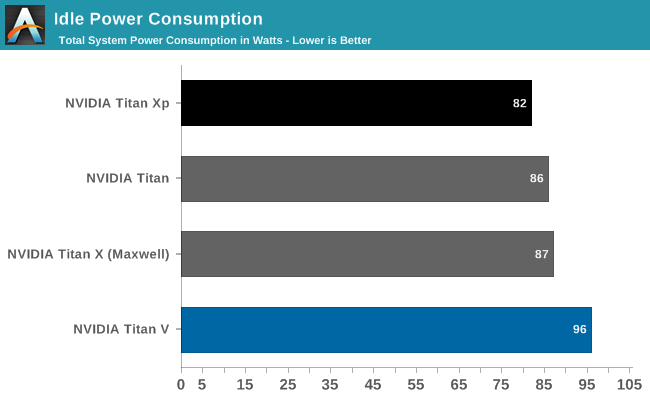
Measuring power from the wall, Titan V's high idle and lower load readings jump out.
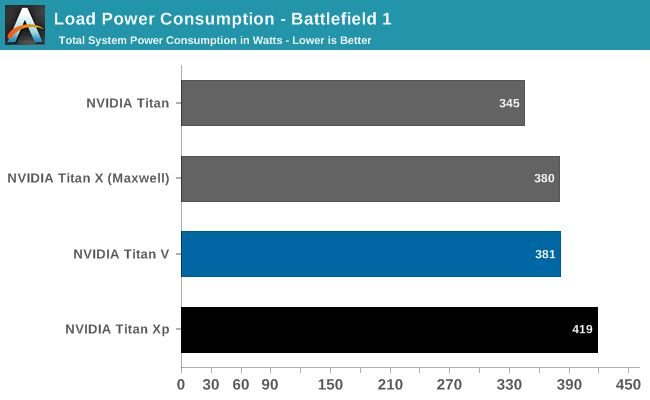
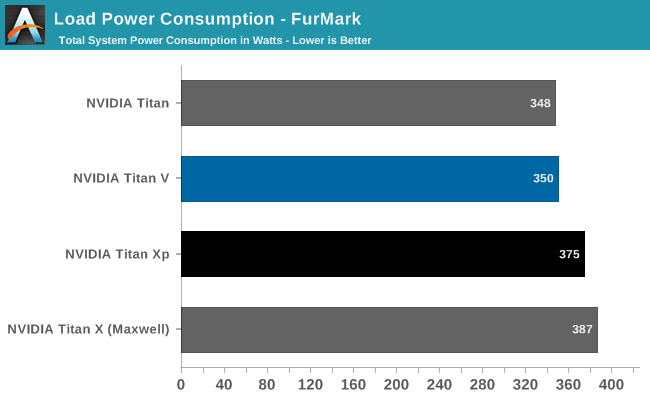
Meanwhile under load, the Titan V's power consumption at the wall is slightly but consistently lower than the Titan Xp's. Again despite the fact that both cards have the same TDPs, and NVIDIA's figures tend to be pretty consistent here since Maxwell implemented better power management.

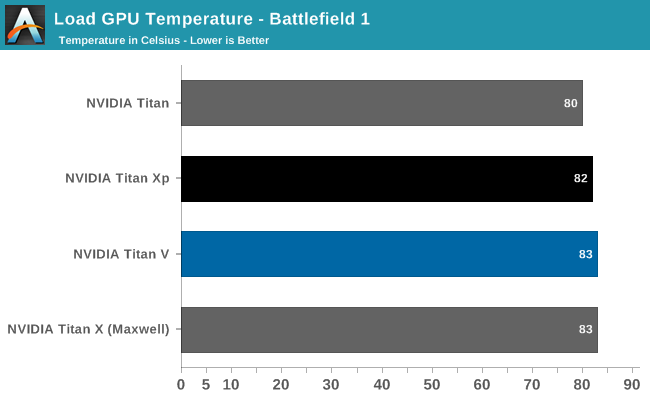
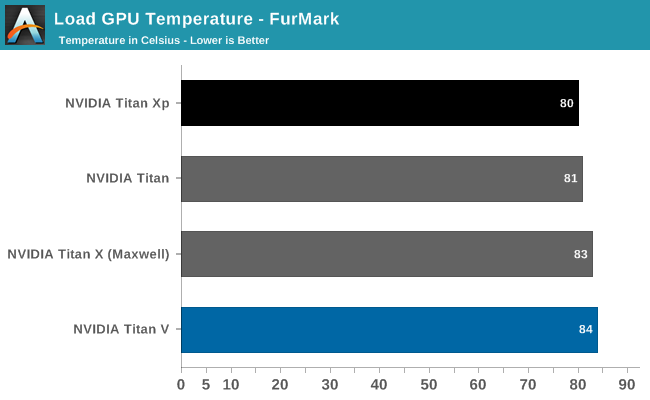
During the course of benchmarking, GPU-Z reported a significant amount of Titan V thermal throttling, and that continued in Battlefield 1, where it oscillated between being capped out by GPU underutilization and temperature. And in FurMark, the Titan V was consistently temperature-limited.
Without HBM2 voltages, it is hard to say if the constant 850MHz clocks are related to Titan V's higher idle system draw. 815mm2 is quite large, but then again elements like Volta's tensor cores are not being utilized in gaming. In Battlefield 1, system power draw is actually lower than Titan Xp but GPU Z would suggest that thermal limits are the cause. Typically what we've seen with other NVIDIA 250W TDP cards is that they hit their TDP limits more often than they hit their temperature limits. So this is an unusual development.
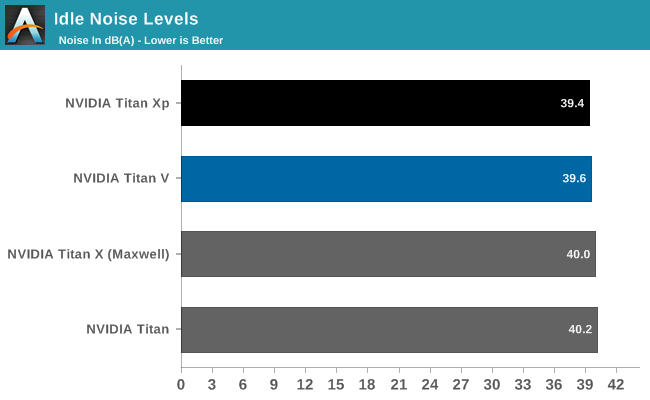
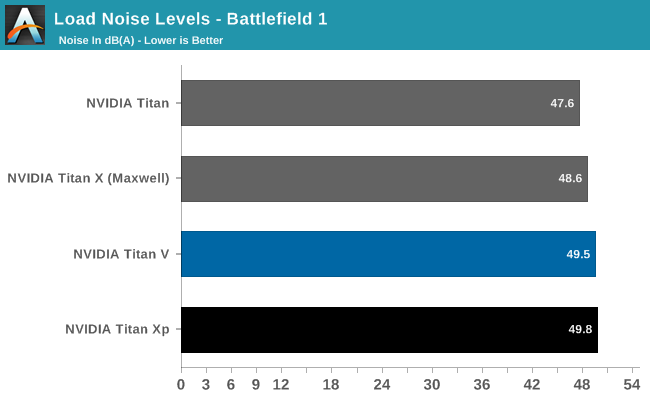
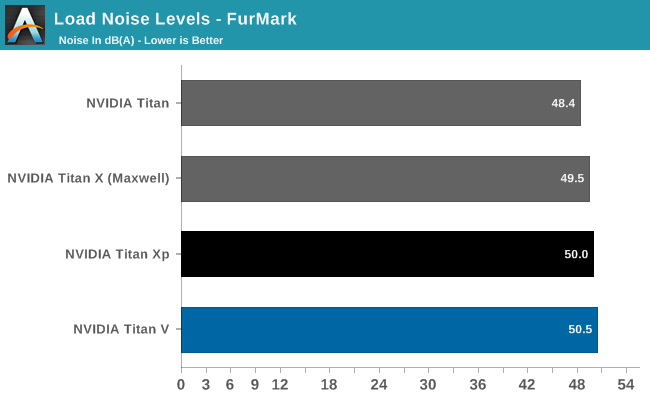
Featuring an improved cooler, Titan V essentially manages the same noise metrics as its Titan siblings.










111 Comments
View All Comments
WB312 - Friday, December 22, 2017 - link
I am from the future, we still can't run Crysis.mode_13h - Wednesday, December 27, 2017 - link
HDMI 2.1 already supports 10k @ 120 Hz, so the bar moves ever higher.Yojimbo - Wednesday, December 20, 2017 - link
Small error: "Rather both Tesla P100 and Titan V ship with 80 SMs enabled, making for a total of 5120 FP32 CUDA cores and 672 tensor cores."80 x 8 = 640. The P100 and Titan V each have 640 tensor cores. 672 is what a full GV100 has.
jabbadap - Wednesday, December 20, 2017 - link
Yeah and that would be Tesla V100, P100 is pascal.Yojimbo - Wednesday, December 20, 2017 - link
Yeah true. I didn't notice that.rocky12345 - Wednesday, December 20, 2017 - link
Great preview of the new Titan V card thank you. I really got a kick out of the "But Can It Run Crysis?" part and you actually gave numbers to back up that question which of coarse it can pretty well.007ELmO - Wednesday, December 20, 2017 - link
of course...it's only a $3000 carddjayjp - Wednesday, December 20, 2017 - link
Crysis at 8K equivalent! 4k = 8 million pixels x 4 super sampled becomes 32 MP. Tho that means there'd be no AA if run on an 8k monitor..and what about 99th percentile? ;)nedjinski - Wednesday, December 20, 2017 - link
what will nvidia do about that nagging crypto mining problem?lazarpandar - Wednesday, December 20, 2017 - link
Make it cost 3kMachine learning is more valuable than crypto